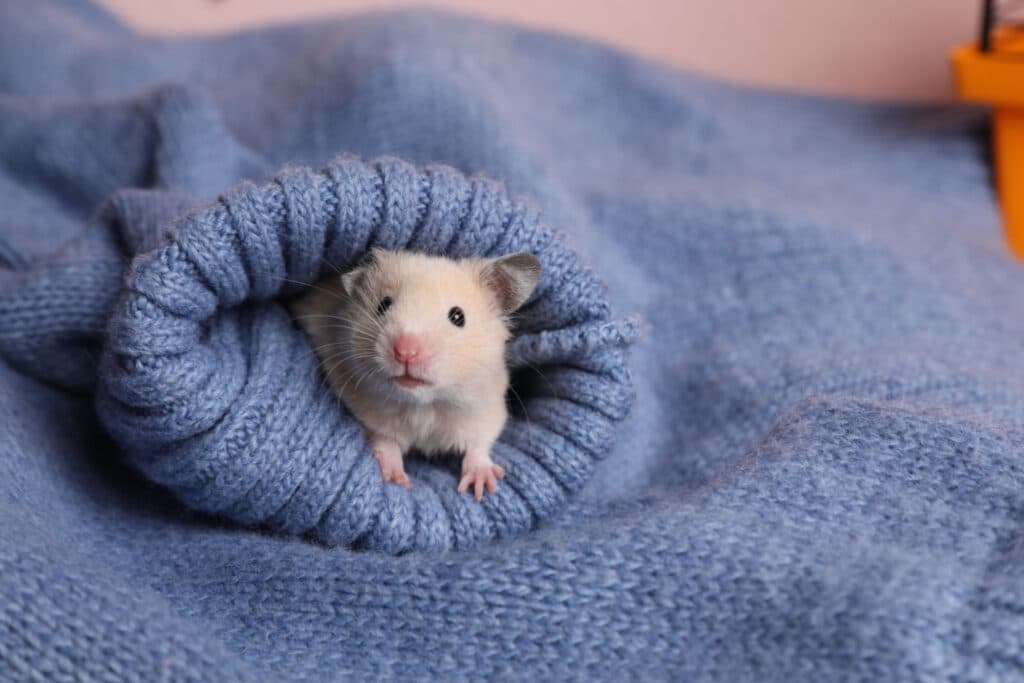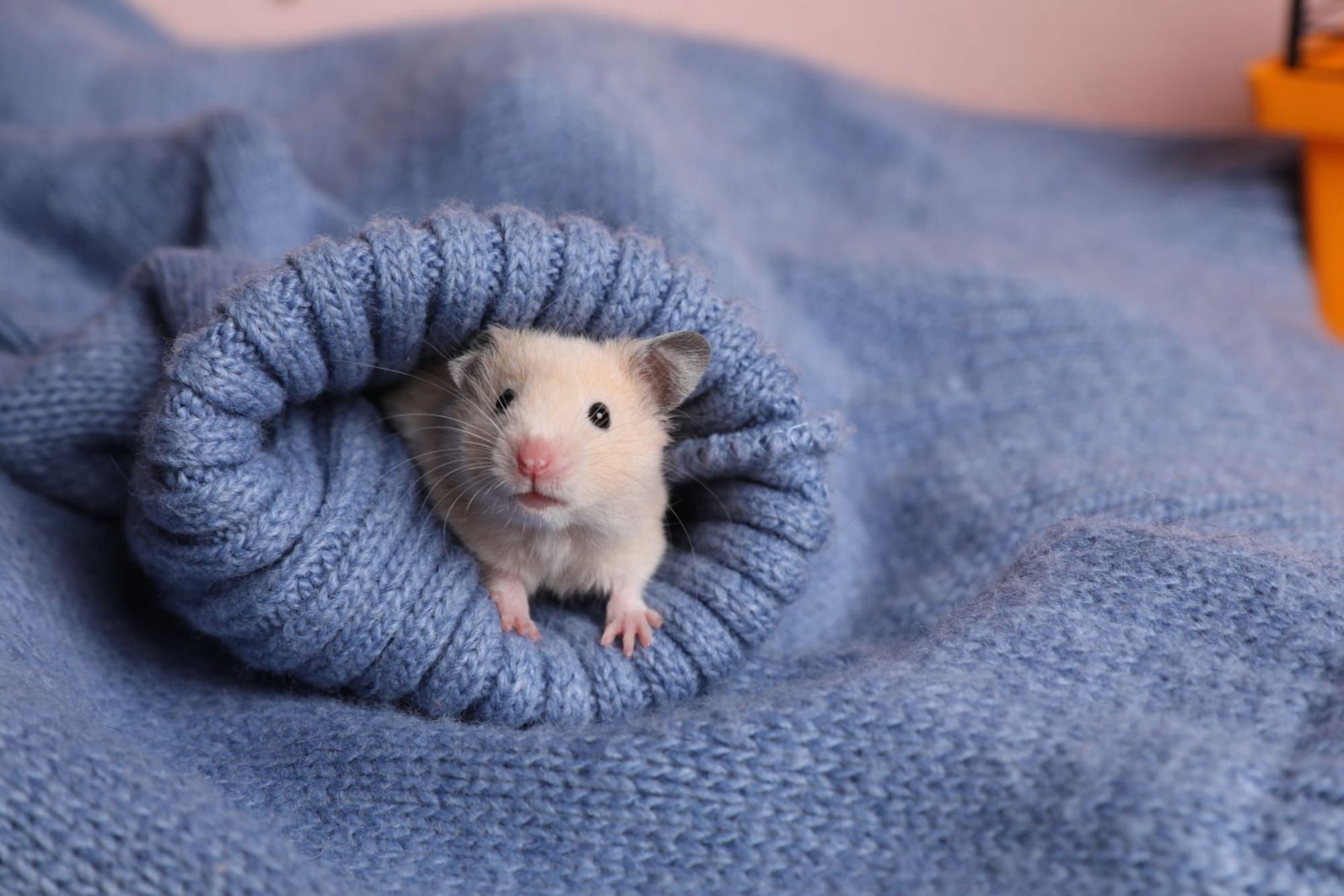Pet hamsters depend entirely on their owners for survival. So, it is our duty to create optimal living conditions for them to lead healthy, long lives. This includes not only providing them nourishing diet and cleaning their cage regularly but also making sure that the room is sufficiently warm. If not, hamsters can get cold.
Read this blog post to find out how to find out if your hamster has got a cold, what to do about it, and how to keep your hamster warm in a cold house.
Can hamsters get cold?
Can hamsters get cold? After all, they have thick furs. So, that should help them survive even at sub-zero temperatures, right? If that’s what you were thinking, you could not be more wrong. Hamsters are tiny animals. Their bodies are not as adept at adapting to temperature changes as humans.
It’s true that hamsters can survive in arid conditions as well as freezing temperatures in the wild. But that’s because they dig tunnels up to 8 feet below the ground, where the temperature doesn’t fluctuate as much as on the surface, and live there. But pet hamsters don’t have the luxury of digging tunnels that deep; they only get a few inches of bedding. So, the room temperature should be between 18°C and 24°C (65°F to 75°F) for them to stay healthy.
Anything below 18°C is too cold for your hamster. If the temperature drops even slightly below 18°C, he can catch a cold. If the temperature drops significantly below 18°C, he can start hibernating, which can be deadly for pet hamsters (For more information, read: Do hamsters hibernate?).

Staying in a cold room is not healthy for humans as well. If you remain in a cold room, your body will lose heat faster than it can produce it. If you stay for too long, your body can lose all the stored energy, resulting in hypothermia (abnormally low body temperature). It can eventually affect your brain, making it difficult for you to think or move properly. Repeated exposure to cold temperatures (< 60°F or 16°C) can also damage the blood vessels in your skin, causing redness and itching (Source: Centers for Disease Control and Prevention).
Therefore, make sure that the room is adequately warm for you and your hamster (Also read: How to keep your hamster warm on a low budget?).
How to find out if the room is too cold for your hamster?
So you have adjusted the room temperature so that it is in the optimal range for your hamster. But what if your hamster is still feeling too cold? How do you find that out?
What will you do if your room is too cold and the room heater doesn’t work?
You will get your quilt or a thick bed sheet, wrap it around you and stay in bed. Won’t you? And if that doesn’t work, you will start shivering and get sick, right?
It is the same for hamsters as well. In the wild, hamsters gather twigs, leaves, and other stuff in their cage, if it is too cold outside. In a similar manner, if the room is too cold for your hamster, he will gather as much bedding as possible and bring it to his nesting area (Source: First Hamster). No amount of extra bedding will be sufficient for him. He might start sleeping more to conserve body heat and energy. He might also start shivering. He might also lose his appetite and become lethargic. These are some symptoms that indicate that the room is too cold for your hamster.
Did your hamster catch a cold? How to find out?
We discussed earlier that if the room is too cold for your hamster, he can catch a cold. But how do you find out if your hamster has caught a cold?
Symptoms of the common cold in hamsters
The symptoms of the common cold in hamsters are mostly similar to those in humans (Source: Main West Animal Hospital, Canada).
- Your hamster may sneeze, cough, or wheeze.
- He may have a wet or runny nose.
- Your hamster may become lethargic and lazy. He could show reduced activity and would want to sleep most of the time.
- His body will be warmer than usual.
- He may feel thirstier and drink more water than usual.
- Water and/or other discharge might come out of his eyes and nose.
When the cold gets severe, the following symptoms can be observed:
- Loss of appetite
- Matted fur
What causes cold in hamsters?
More than 200 viruses can cause the common cold. But the most common type among them all is the rhinovirus (Source: Centers for Disease Control and Prevention). In humans, rhinovirus was found to replicate (within the body) efficiently at temperatures lower than the core body temperature. The virus thrives at a temperature range of 91°F to 95°F. Its replication was slowed down significantly when the body temperature reached 98.6°F (Source: The Discover Magazine).
On the other hand, the immune system can fight the rhinovirus more efficiently at higher temperatures than at lower temperatures. Researchers who tested cells taken from the airways of mice against rhinovirus found that the cells launched a more robust attack against rhinovirus at 98.6°F when compared to 91°F (Source: Proceedings of the National Academy of Sciences, USA).
The normal body temperature of a human adult varies between 97°F and 99°F (Source: WebMD). In comparison, the normal body temperature of a hamster varies between 97°F and 102.3°F (Source: Lafeber Vet). As you may already know, a decline in room temperature leads to a reduction in body temperature. So, cold weather or a decline in room temperature increases the risk of catching a cold in both humans and hamsters.
So, if the room temperature falls below 65°F, your hamster is more likely to catch a cold.
Can hamsters catch a cold from humans?
The common cold is contagious. So, if you have a cold and touch your hamster, he could catch your cold. So, don’t touch your hamster if you have a cold. Wash your hands properly before filling his food bowl with treats. Use gloves if possible.
If you keep water in a bowl for your hamster to drink, your hamster can catch a cold easily because bowl water can get contaminated quickly.
How to treat your hamster’s cold?
There isn’t any cure for the common cold. You can take your hamster to a vet. He will prescribe antibiotics that can help reduce the symptoms. But the cold itself will not go away instantly. It will take up to a week for your hamster’s cold to go away. But you can perform the following steps to help your hamster survive the cold:
- Make sure that the room is neither colder than 65°F nor hotter than 75°F.
- Make sure that the room is properly ventilated.
- Clean and disinfect the cage and change the bedding.
- If you keep multiple hamsters in the cage, separate the sick hamster from the healthy hamsters.
- Provide enough bedding material for your hamster so that he can build a safe, warm nest to keep himself warm.
- Make sure that the cage is warm enough. Do not keep the cage near a window or door, particularly during winter months.
- Offer some warm milk, water, and honey to your hamster. After all, honey is an effective cough suppressant (Source: Mayo Clinic).
- Avoid food items that can affect the cold. For example, sugar is one food item that should be avoided when your hamster is suffering from a cold. Even though it doesn’t worsen the cold, it might suppress the immune system by causing inflammation (Source: Live Strong). This can weaken the body’s defenses and make it difficult for your hamster to recover. So, refined carbs, like white bread or pasta, should be avoided when your hamster has a cold because these can be broken down quickly into sugar, causing an increase in blood sugar levels (Source: The Healthy).



